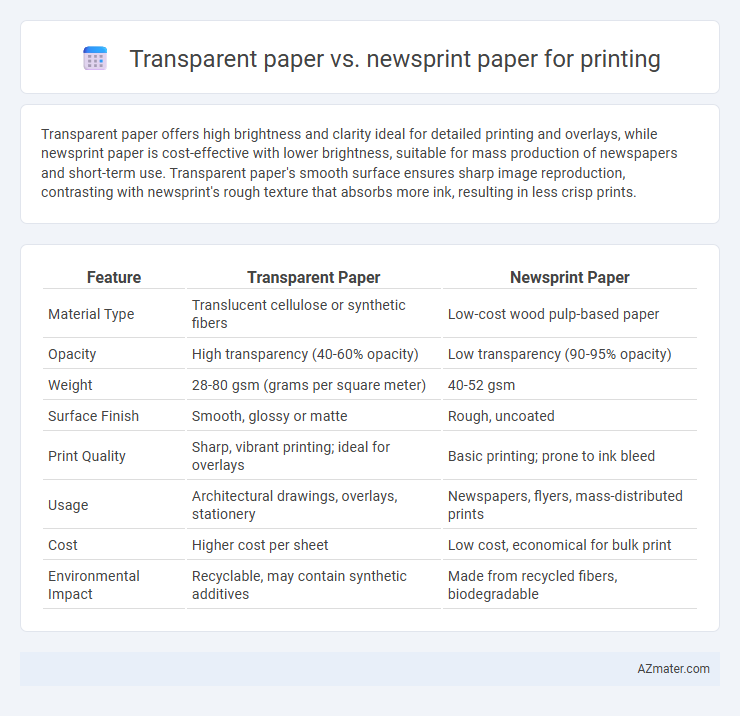Transparent paper offers high brightness and clarity ideal for detailed printing and overlays, while newsprint paper is cost-effective with lower brightness, suitable for mass production of newspapers and short-term use. Transparent paper's smooth surface ensures sharp image reproduction, contrasting with newsprint's rough texture that absorbs more ink, resulting in less crisp prints.
Table of Comparison
| Feature | Transparent Paper | Newsprint Paper |
|---|---|---|
| Material Type | Translucent cellulose or synthetic fibers | Low-cost wood pulp-based paper |
| Opacity | High transparency (40-60% opacity) | Low transparency (90-95% opacity) |
| Weight | 28-80 gsm (grams per square meter) | 40-52 gsm |
| Surface Finish | Smooth, glossy or matte | Rough, uncoated |
| Print Quality | Sharp, vibrant printing; ideal for overlays | Basic printing; prone to ink bleed |
| Usage | Architectural drawings, overlays, stationery | Newspapers, flyers, mass-distributed prints |
| Cost | Higher cost per sheet | Low cost, economical for bulk print |
| Environmental Impact | Recyclable, may contain synthetic additives | Made from recycled fibers, biodegradable |
Introduction to Transparent Paper and Newsprint Paper
Transparent paper, known for its smooth, translucent surface, is commonly used in tracing, overlays, and high-quality printing applications requiring clarity and precision. Newsprint paper, a lightweight, inexpensive paper made from wood pulp, serves primarily for printing newspapers and mass-produced materials where cost efficiency and rapid production are essential. Both papers vary significantly in opacity, texture, and durability, influencing their suitability for different printing needs and aesthetic outcomes.
Key Properties of Transparent Paper
Transparent paper offers high translucency, making it ideal for tracing, overlays, and detailed design work where visibility through the paper is crucial. Its smooth surface ensures precise ink adhesion and prevents bleeding, which enhances print clarity compared to the coarse, fibrous texture of newsprint paper. Unlike newsprint, transparent paper has superior durability, moisture resistance, and brightness, providing consistent print quality for technical drawings, presentations, and specialty art projects.
Key Properties of Newsprint Paper
Newsprint paper is a lightweight, low-cost paper primarily made from mechanical pulp, ideal for high-speed printing like newspapers due to its excellent ink absorption and fast drying properties. Its lower brightness and opacity compared to transparent paper result in less show-through, making text and images crisp for mass circulation. Newsprint's flexibility and recyclability contribute to its widespread use in short-term print materials, contrasting with transparent paper's specialty applications requiring clarity and durability.
Print Quality Comparison
Transparent paper offers superior print quality with high opacity and sharp image reproduction, making it ideal for detailed graphics and professional documents. Newsprint paper, designed for cost-effective mass production, delivers lower resolution and duller colors due to its coarse texture and absorbent fibers. The choice between transparent paper and newsprint paper significantly impacts print clarity, color vibrancy, and overall presentation quality.
Applications of Transparent Paper in Printing
Transparent paper is widely used in printing applications that require clarity and light transmission, such as architectural overlays, tracing, and technical drawings. Its smooth surface supports high-quality ink adhesion, making it ideal for detailed illustrations, art prints, and promotional materials like brochures and invitations. Unlike newsprint paper, transparent paper excels in presentations where color vibrancy and sharpness are essential.
Applications of Newsprint Paper in Printing
Newsprint paper is widely used in printing for newspapers, flyers, and brochures due to its low cost and high absorbency. Its lightweight and porous nature make it ideal for high-speed rotary presses, allowing efficient mass production of daily publications and promotional materials. Unlike transparent paper, newsprint is not suitable for detailed or vibrant color printing but excels in rapid, large-volume output where affordability is key.
Durability and Longevity
Transparent paper offers superior durability and longevity compared to newsprint paper due to its high-quality cellulose fibers and resistance to yellowing or tearing. Newsprint paper, made from low-grade wood pulp, is more prone to rapid deterioration, fading, and brittleness when exposed to light and environmental factors. For long-term printing projects requiring archival quality, transparent paper provides a more reliable and lasting solution.
Cost-Effectiveness and Availability
Transparent paper generally costs more than newsprint paper due to its specialized production process and higher material quality, making it less cost-effective for large-volume printing projects. Newsprint paper is widely available and inexpensive, favored for budget-conscious printing needs like newspapers and flyers, where high durability and clarity are not critical. Businesses prioritizing affordability and easy procurement often choose newsprint paper, while transparent paper suits niche applications demanding translucency despite higher costs.
Environmental Impact and Recyclability
Transparent paper, often made from cellulose fibers with fewer chemicals, offers higher recyclability and biodegradability compared to newsprint paper, which contains higher levels of lignin leading to lower recyclability and increased environmental pollution. Newsprint paper production typically involves significant energy consumption and emissions due to the pulping and bleaching processes, contributing to deforestation and water pollution. Choosing transparent paper reduces landfill waste and supports sustainable forestry practices, making it a more eco-friendly option for printing.
Choosing the Right Paper for Your Printing Needs
Choosing the right paper for your printing needs depends on the purpose and desired quality of the final product. Transparent paper offers high translucency and crisp image reproduction, making it ideal for overlays, design proofs, and artistic projects that require detail and visual layering. Newsprint paper, characterized by its low cost and high absorbency, suits mass printing of newspapers and flyers where quick drying and affordability are prioritized over sharp image clarity.

Infographic: Transparent paper vs Newsprint paper for Printing
 azmater.com
azmater.com